Picture solar panels, and you’re most likely picturing a solid square slab. But the tech is becoming more flexible, and now engineers at Pusan National University in Korea have developed prototype solar cells that are fully foldable.
Rigid solar cells are great for sticking on rooftops and huge solar farms, but they could use a little more flexibility to make it easier to transport them, or get the tech into vehicles, phones, indoor devices, or even clothing.
In recent years, flexible solar cells have shown promise for all of these kinds of applications. They’re usually made of thin-film materials like graphene, tungsten diselenide, or copper indium gallium selenide (CIGS), deposited onto flexible substrates like polymers or even paper. The result is a solar cell that can bend to a limited degree, like a card.
But so far, they haven’t been able to fully fold in half without breaking. Other electronic devices are beginning to gain that ability, as seen with Samsung’s Galaxy Fold phones (among others) that can open and close like a book.
“Unlike merely flexible electronics, foldable devices are subject to much harsher deformations, with folding radii as small as 0.5 mm,” says Professor Il Jeon, corresponding author of the study. “This is not possible with conventional ultra-thin glass substrates and metal oxide transparent conductors, which can be made flexible but never fully foldable.”

To address that concern, the researchers turned to conductive films made of single-walled carbon nanotubes (SWNTs). They embedded this film onto a polyimide substrate, then doped it with molybdenum oxide to improve its conductivity.
In the end, the researchers were able to make a solar cell just seven micrometers thick that could fold to a radius of just 0.5 mm. They were able to withstand over 10,000 folding cycles without breaking. They of course also functioned decently well as solar cells too, exhibiting a power conversion efficiency of 15.2 percent and 80 percent transparency.
“The obtained results are some of the best among those reported thus far for flexible solar cells, both in terms efficiency and mechanical stability,” says Jeon.
The research was published in the journal Advanced Science.
Source: Pusan National University





